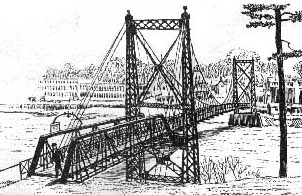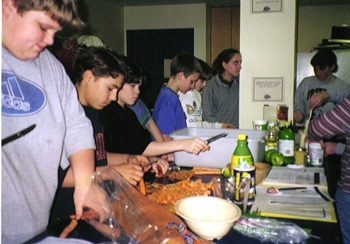 |
Kotlas - Waterville Area Sister City Connection P.O. Box 1747 Waterville, ME 04903-1747 Write to Us |
 |
|
Home > Projects > Russian Sampler > 1998 Program Middle Schoolers Sample Russia
Over 200 middle school students from as far away as Freeport gathered at Colby College on March 23 to learn about Russia, her past, and her present. The Sampler was sponsored by Colby's Department of German and Russian and the Kotlas - Waterville Area Sister City Connection. For most students, the day was one of eye-openers. All attended four workshops and presentations they had selected from a wide variety of offerings. Most had the opportunity to try out a new alphabet when they wrote their names in Russian. They learned some brief phrases and then tried them out on friends as they met in the halls. First-hand knowledge was shared by a panel of exchange students from Moldova, Russia, Ukraine, and Belarus, countries formed from the former Soviet Union. These high school students talked about the differences between US and Russian life. They find school much more relaxed here. There is very little choice in courses taken in their schools at home. Everyone throughout the country takes the same courses. Computers are few and usage is restricted. Girls and boys are separated for some classes. They have lots of homework! Imagine not having any school sports teams and no study halls! Classes in physics and biology begin at Grade 7 and meet twice a week. Courses in algebra and geometry start much earlier than here. Foreign language instruction begins in Grade 5 and by the time students graduate from Grade11, they speak at least one foreign language. Subjects aren't repeated from year to year and students are tested only twice a year. Saturday classes are still the norm in some schools. The Americans were quite surprised at the differences. "Maybe it would be a good place to visit, but I wouldn't want to go to school there," was a common student remark. "Iwas really surprised that most Russian kids listen to the same music we do. Somehow I thought their music would be much different," commented Winslow seventh grader Nick Gallagher about a session on Russian rock music taught by Prof. Dennis Browne of Bates College in Lewiston. The music and dance sessions were really popular with the kids and their chaperones. Some learned a variety of folk dances. In the art classes, some students created Ukrainian Easter eggs (very carefully!), while others painted Russian designs on wooden boards. Still others painted tiny, clay animals to take home.
You'd never think of stamp collecting as a way to teach history, but that's what Dr. John Engle, a nephrologist at MaineGeneral Medical Center, did. And students were fascinated to learn who the people on the stamps were and how postage prices had changed over time. Envelopes are formatted really differently in Russia, with the return address on the bottom. Everyone also took home some stamps. The day was packed full of learning about a totally different culture, with sessions ranging from "The Rise and Fall of Communism" to "Russia on the Internet" to "Travel Advice". It was quite an opportunity for middle school students to have learning come alive and learn from first hand experiences. We wish everyone would have the same opportunity to truly make the world a smaller, better place. By Mary Coombs In the photos: Betty Campbell's cooks prepare the midday meal. Photographs by Gregor Smith. (Note: This article was orginally published in the Spring/Summer 1998 issue of the Kotlas Connection's newsletter.) <— Previous • Top • Intro • Next —> |
 Why did Ivan the Terrible kill his own son?" was a question asked of Dr. Christine Holden, a professor from the University of Southern Maine, as she gave a lecture on Russian history. Holden was a presenter at Monday's sixth annual Russian Sampler Day held on the Colby campus. Her questioner was an eighth grade student from Central Maine.
Why did Ivan the Terrible kill his own son?" was a question asked of Dr. Christine Holden, a professor from the University of Southern Maine, as she gave a lecture on Russian history. Holden was a presenter at Monday's sixth annual Russian Sampler Day held on the Colby campus. Her questioner was an eighth grade student from Central Maine. Food is always a great way to make friends. Fairfield foster mom Betty Campbell had her charges preparing Moldovan vegetable soup and different salads for everyone to share at lunch. Other students made Russian tea cakes, which were very popular.
Food is always a great way to make friends. Fairfield foster mom Betty Campbell had her charges preparing Moldovan vegetable soup and different salads for everyone to share at lunch. Other students made Russian tea cakes, which were very popular.